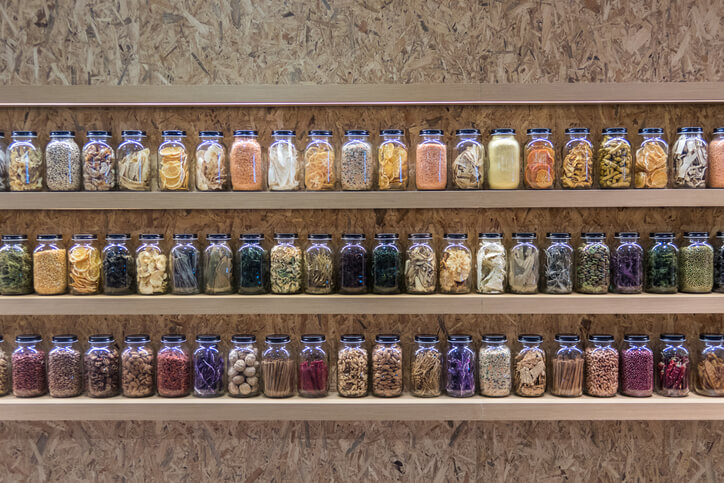Spice Rack Rules Every Mom Needs to Know
7 years ago | Nutrition
By Joy Stephenson-Laws, JD, Founder
Like myself, you probably have a spice rack or cabinet at home which house a variety of dried herbs and spices. They have a very long shelf life and are great flavoring agents.
Herbs and spices may help to reduce your salt intake (especially when cooking healthy meals at home). They are also very nutrient-dense. For example, just one cup of parsley contains 332 mg of potassium, an essential mineral for heart health. And spices such as cumin, oregano, cayenne pepper, ginger and more also contain important nutrients including calcium, magnesium, phosphorus and vitamin A. Additionally, spices and herbs contain anti-inflammatory properties which may boost immunity and aid in digestion. These powerhouse ingredients may even get your kids to eat more vegetables.
However, it is important to be aware that, like most things, herbs and spices may be contaminated. A recent report discusses a small-scale study in North Carolina where researchers found lead contamination in spices in the homes of children who exhibited elevated blood lead levels. (Lead is a metal that is naturally present in the earth’s crust).
“The food items that had the highest levels of lead in the North Carolina study included samples of chili powder/red pepper, cumin, coriander, anise, turmeric and vanilla,” according to the report.
And as you probably already know, exposure to lead can be very harmful (especially in children).
“A child who swallows large amounts of lead may develop anemia, severe stomach ache, muscle weakness, and brain damage. Even at low levels, lead can affect a child's mental and physical growth,” reports the National Institutes of Health (NIH).
“Lead can be found in all parts of our environment. Much of it comes from human activities such as mining and manufacturing. Lead used to be in paint; older houses may still have lead paint.”
Older homes may also have water pipes that contain lead and can contaminate drinking water. Lead has also been found in products, like lipstick. And of course, we can’t forget how lead played a role in the Flint, Michigan water crisis.
The study which discovered the contaminated spices looked at 938 homes in North Carolina from January 2011 to January 2018 (there were 61 children in 59 properties that were included in the final report).
Most of the children lived in new homes, so the explanation for elevated blood lead levels was not connected to living in an older home where lead paint or older pipes were present.
“In 32 of the homes, there was no evidence of lead in paint, dust, mini-blinds, faucets, bathtub glaze or furniture finish. But in seven of the homes, the researchers found that the collected samples of spices, herbal remedies and ceremonial powders (non food products used for social or religious markings) - which children might accidentally ingest—contained high levels of lead,” the report states.
A wider body of research has shown that in general not many American children consume spices, however, those with parents who immigrated from Southeast Asia tend to have more spice in their diets.
Why is This Lead Contamination Happening?
“About 95 percent of the spices consumed in the U.S. are imported and often grown in countries polluted by leaded gasoline, smelters, battery-manufacturing plants and mines. In addition, the spices also may be deliberately adulterated with lead to enhance color or increase weight. Regulation is complicated by internet sales and importation through consumer travel.”
We also have to keep in mind, that the Food and Drug Administration (FDA) does not monitor or regulate everything.
How Can You Be Proactive?
This study was small, and you shouldn’t toss everything in your spice cabinets. But you can use this as a reminder to be more aware of what you are putting in your body.
Perhaps, using fresh foods when possible is best. For example, use fresh parsley over dried parsley that comes in a container. The fresh parsley may be less likely to have lead and can be thoroughly washed before you use it. Also be mindful of buying products online.
You can also do an at-home lead test for drinking water and surfaces in the home your child comes into contact with. For other ways you can protect your home, read here.
It might not also be a bad idea to get your blood lead level checked as well as your child’s. If high levels are detected, you can work on nailing down what the culprit is. And if you rule out that the culprit is not an older home with lead paint or older pipes, it may be in something you are eating.
In fact, a yearly blood lead test is advised for children up to six years of age, according to one medical source. Also keep in mind that people with high levels of lead in their bodies do not always appear sick, so this is why testing is so important. Consider testing for lead as part of your round of tests, like blood pressure testing, BMI and nutrient testing.
Finally, speak with your pediatrician or a competent healthcare professional about your concerns and whether you should be including certain spices and herbs in your child’s diet.
Enjoy your healthy life!
The pH professional health care team includes recognized experts from a variety of health care and related disciplines, including physicians, attorneys, nutritionists, nurses and certified fitness instructors. This team also includes the members of the pH Medical Advisory Board, which constantly monitors all pH programs, products and services. To learn more about the pH Medical Advisory Board, click here.







